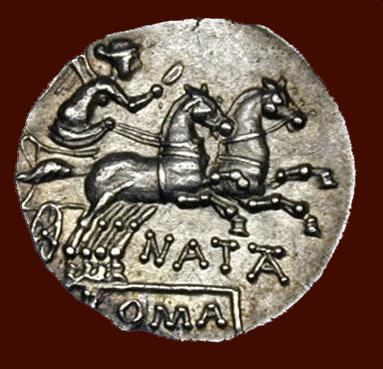








Designed by Nigel G Wilcox






The Paragon Of Metal Detecting
& Archaeology
& Archaeology
Powered By Sispro1
Roman Denarius A.D. - Currency Numismatics,
For Reference ONLY
Everything For The Detectorist
Sestertius of Claudius 50-54 AD
Roman Timeline
Roman Menu
Copyright All Rights Reserved by Nigel G Wilcox E-Mail: ngwilcox100@gmail.com
1.
Roman Orichalcum Sestertius of Claudius (50-54 C.E.), Probably the Finest Known
Claudius, 50 - 54
Sestertius circa 50-54, Æ 27.68 g. TI CLAVDIVS CAESAR AVG P M TR P IMP P P Laureate head r. Rev. NERO CLAVDIVS DRVSVS GERMAN IMP S - C Triumphal arch surmounted by an equestrian statue r., between two trophies; the rider strikes downwards with spear in r. hand. C 48. BMC 188. RIC 114. CBN 212.
Rare and probably the finest specimen known. A vigorous portrait struck on a full flan and a finely detailed reverse composition with an untouched brown green patina. Virtually as struck and almost Fdc
Of the several triumphal arches that Claudius built or created by modifying existing structures (such as the Aqua Virgo aqueduct), we are fortunate that some are represented on coinage he struck for himself and for his long-deceased brother, Nero Claudius Drusus. However, only the Arcus Drusi is shown on a sestertius, a coin large enough to allow us to appreciate the structure and ornamentation even down to the smallest details. First, it may be observed that there are four Ionic columns supporting the attic, which in its centre has a temple-like pediment. Next, the roof is decorated with the military emblems - trophies flanking an equestrian statue of Drusus raising a spear - whereas the façade of the attic is decorated with emblems of the priestly colleges to which Drusus must have belonged. Four different types of priestly implements are shown. The two largest are a patera at the left, a one-handled ewer (urceus) at the right, and in the centre there are smaller renderings of a simpulum within the pediment and two litui (augural staffs) to each side. The Inscriptiones Latinae Selectae 146 f. records that Drusus was augur, which is confirmed here by the presence of two litui. The patera suggest he was one of the septemviri, the jug may relate to the flamen Dialis, and the simpulum perhaps indicates that he belonged to the priestly college of the quindecimviri Sacris Faciundis (‘fifteen men for the conduct of sacred matters’). This arch spanned the Via Appia and may have been erected by Augustus not long after Drusus died in 9 B.C., or it may have been a project of either his brother Tiberius or his son Claudius. Hill suggests that the arch shown on aurei and denarii which Claudius struck in Drusus’ name (to which we may add certain didrachms of Caesarea in Cappadocia) is the same as the one illustrated on this sestertius, but that on those smaller coins the image was simplified
Claudius, 50 - 54
Sestertius circa 50-54, Æ 27.68 g. TI CLAVDIVS CAESAR AVG P M TR P IMP P P Laureate head r. Rev. NERO CLAVDIVS DRVSVS GERMAN IMP S - C Triumphal arch surmounted by an equestrian statue r., between two trophies; the rider strikes downwards with spear in r. hand. C 48. BMC 188. RIC 114. CBN 212.
Rare and probably the finest specimen known. A vigorous portrait struck on a full flan and a finely detailed reverse composition with an untouched brown green patina. Virtually as struck and almost Fdc
Of the several triumphal arches that Claudius built or created by modifying existing structures (such as the Aqua Virgo aqueduct), we are fortunate that some are represented on coinage he struck for himself and for his long-deceased brother, Nero Claudius Drusus. However, only the Arcus Drusi is shown on a sestertius, a coin large enough to allow us to appreciate the structure and ornamentation even down to the smallest details. First, it may be observed that there are four Ionic columns supporting the attic, which in its centre has a temple-like pediment. Next, the roof is decorated with the military emblems - trophies flanking an equestrian statue of Drusus raising a spear - whereas the façade of the attic is decorated with emblems of the priestly colleges to which Drusus must have belonged. Four different types of priestly implements are shown. The two largest are a patera at the left, a one-handled ewer (urceus) at the right, and in the centre there are smaller renderings of a simpulum within the pediment and two litui (augural staffs) to each side. The Inscriptiones Latinae Selectae 146 f. records that Drusus was augur, which is confirmed here by the presence of two litui. The patera suggest he was one of the septemviri, the jug may relate to the flamen Dialis, and the simpulum perhaps indicates that he belonged to the priestly college of the quindecimviri Sacris Faciundis (‘fifteen men for the conduct of sacred matters’). This arch spanned the Via Appia and may have been erected by Augustus not long after Drusus died in 9 B.C., or it may have been a project of either his brother Tiberius or his son Claudius. Hill suggests that the arch shown on aurei and denarii which Claudius struck in Drusus’ name (to which we may add certain didrachms of Caesarea in Cappadocia) is the same as the one illustrated on this sestertius, but that on those smaller coins the image was simplified

Information Data
Main Coin Menu
Roman Coin Menu
Member NCMD
R-Art Menu
























